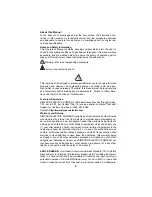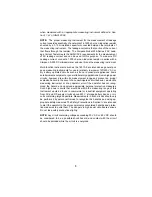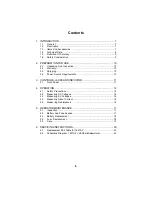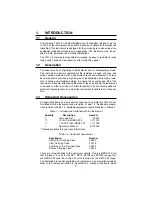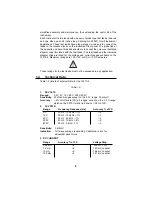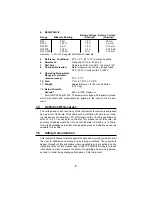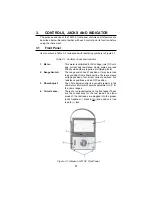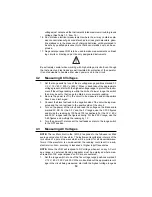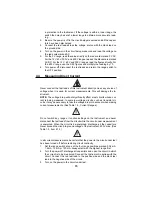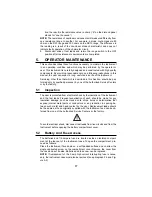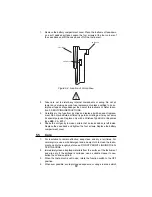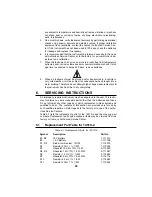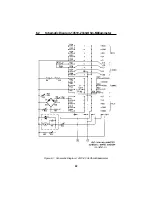
13
refer to the equipment manual and its specific warnings and instructions, and
observe them as well as those contained herein.
1.
The 14510-2 should only be used by personnel qualified to recognize
shock hazards and trained in the safety precautions required to avoid
possible injury.
2.
Do not connect any terminal of this Instrument to a circuit point at which a
voltage exceeding 600 volts AC or DC may exist with respect to earth
ground. (Refer to Table 1-3, item 12.)
3.
This Instrument is intended only for use indoors or in sheltered locations.
To prevent fire or shock hazards, do not expose it to rain or moisture.
Condensation may occur when the Instrument is moved from a cold area
to a warm area. DO NOT ATTEMPT HIGH VOLTAGE MEASUREMENTS
UNTIL CERTAIN THAT THE INSTRUMENT HAS DRIED THOROUGHLY.
4.
Turn off power and discharge any capacitors in the circuit to be mea-
sured before connecting to or disconnecting from it.
5.
Before using this Instrument, check accessories (if any) and test leads
for missing, damaged, deteriorated or otherwise faulty insulating parts.
Do not use, or permit the use of, equipment with faulty insulation until it
has been properly repaired.
IMPORTANT:
6.
Always wear safety glasses when working with electrical circuitry.
7.
Do not work alone on high voltage circuits. Make certain that someone
capable of rendering aid is nearby and aware.
8.
Do not handle the Instrument, its test leads or the circuitry while taking
any measurements.
9.
Be sure to reset the range switch to the OFF position after completing
resistance or current measurements. This is to prevent inadvertent appli-
cation of high voltage to the resistance or current ranges when the In-
strument is next used.
10. Hands, shoes, floor and workbench must be dry. Avoid measurements
under humid, damp or other environmental conditions that could affect
the dielectric withstanding voltage of the test leads of the Instrument.
11. Do not change switch settings or test lead connectionswhile the circuit is
energized. A mistake could result in damage to the Instrument and pos-
sible personal injury.
12. Locate all voltage sources and accessible current paths before making
connections to circuitry.
NOTE: Voltage may appear unexpectedly or in unexpected locations in faulty
equipment. An open bleeder resistor, for example, may result in a capacitor
retaining a dangerous charge.
13. Make certain that the equipment being worked upon is properly grounded
and fuses are of the proper type and rating.
14. Check and double check switch positions and jack connections before
applying power to the Instrument.
15. Always remain alert for low voltage circuits which may be floating at high
voltage with respect to earth ground and for composite voltages (AC +
DC) such as are found in rf amplifiers. The floating voltage or composite
Summary of Contents for 14510-2
Page 1: ...Simpson 14510 2 Volt Ohm Milliammeter OPERATOR S MANUAL...
Page 4: ...4 NOTES...
Page 5: ...5 NOTES...
Page 23: ...23 NOTES...


